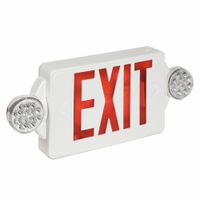- Home
- Lighting
- Emergency Exit Lighting
- Combination Exit Signs Emergency Lights
Combination Exit Signs & Emergency Lights
Combination exit signs with emergency lights are all-in-one fixtures that mark exits and illuminate pathways to guide evacuations from buildings. They hardwire into an electrical system and automatically switch to their battery backup after a power loss to keep the exit sign lit and turn on the emer .....Read More
Frequently Asked Questions
What are combination exit signs with emergency lights?
How do combination exit signs with emergency lights work?
What are the installation requirements for combination exit signs with emergency lights?
How long do the batteries last in combination exit signs with emergency lights?
What are the testing and maintenance requirements for combination exit signs with emergency lights?
Where should combination exit signs with emergency lights be installed?
What are the differences between general purpose and wet location exit light combos?

